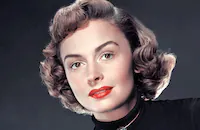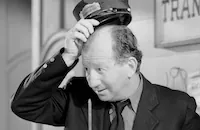Three Hours to Kill

Brief Synopsis
Cast & Crew
Alfred Werker
Dana Andrews
Donna Reed
Dianne Foster
Stephen Elliot
Richard Coogan
Film Details
Technical Specs

Synopsis
Former stage guard Jim Guthrie returns to his home town three years after being falsely accused of murder to learn the identity of the true killer. When Jim comes upon his former friend, bartender Sam Minor, and demands to know why Sam participated in the town's attempt to lynch him, Sheriff Ben East intervenes. Jim voluntarily goes to jail, and there describes how he spent three miserable years on the run until hearing of Ben's appointment as sheriff. Believing Ben's honesty might help him to solve the crime, Jim says he risked returning. When Ben presses him, Jim then explains the night that changed his life three years earlier: At a town dance given by saloon owner Marty Lasswell, Jim quietly celebrates his upcoming engagement to Laurie Mastin and politely evades a dance request by pretty Chris Plumber. When Laurie arrives with her brother Carter, she and Jim slip outside to discuss how to break the news of their engagement to the overly protective Carter. They are interrupted by Niles Hendricks, who asks Laurie to dance just as Carter comes outside looking for his sister. After Niles and Laurie depart, Carter orders Jim to leave Laurie alone, and when Jim blurts out their intention to marry, Carter warns him that no one in town will help him if Carter so requests. Carter then threatens to kill Jim should he persist. The men fight and Carter knocks Jim out. When Jim revives moments later, Carter is lying dead nearby. The crowd at the dance rush outside to find Jim standing over Carter, holidng his gun. Marty examines the gun and discovers that two shots have been fired, prompting the crowd, led by barber Deke, Niles and Sam to call for Jim's immediate punishment. Laurie's attempts to stop the mob cause the horse and wagon carrying Jim to bolt, and Jim escapes. In the present Jim pleads with Ben to give him time to find the real killer, and Ben grants Jim the three hours until sunset to avoid arrest. When Marty observes Jim leaving the jail, he makes plans to depart town immediately. Sam, armed with a pistol, lies in wait for Jim, but he spots the bartender's reflection in a shop window and rushes into Deke's barbershop. Jim accuses Deke of Carter's murder because of money he owed him, but Deke insists he is innocent. Later, at the local hotel, Jim meets Chris, who reveals that she has waited for him, always believing in his innocence. Chris is dismayed by Jim's bitterness, however, and disappointed when Jim reveals he is still in love with Laurie. Meanwhile, Ben tells a panicked Sam, Marty and Deke that they must all remain in town, declaring that the first one to flee will appear guilty. Shortly afterward, Jim arrives at Niles's ranch and is stunned to discover that Laurie has married Niles and has a young son, Carter, Jr., who Jim immediately realizes is his own son. When Jim insists upon confronting Niles, Laurie grows angry at his belief that she would knowingly marry her brother's killer. After the two quarrel, Niles's top hand Esteban misleads Jim, sending him to find Niles in the hills. Niles, who has been warned of Jim's return by Ben's deputy Vince, returns home for a rifle and despite Laurie's pleas, says the only way to save their marriage is to kill Jim. Niles then confronts Jim in the hills, but their fight is stopped by Vince, who arrests Jim. Jim escapes, however, and Chris visits Ben at the jail, worried about Jim's safety, but Ben discloses that a federal marshal is on the way to arrest Jim. Laurie drives into town with little Carter to ask Ben to prevent Jim and Niless' meeting, and after Ben departs, Chris convinces Laurie to tell Jim that she still cares for him, so he will no longer feel a need for revenge. When Jim rides into town, Laurie meets him, tearfully stating that she married Niles only because of her pregnancy. he pleads with Jim to leave, promising to come with him, but when she admits that she believes him guilty of Carter's murder, Jim is disgusted. Later, Marty, Niles, Deke and Sam meet in the saloon, where Jim finds them. The men argue about the events surrounding Carter's death until Marty frankly acknowledges his involvement in the attempted lynching and says that he may know the identity of Carter's killer. Shortly afterward, Jim returns to the jail to turn himself in to Ben, and asks for a public trial. Ben, convinced that Jim will be found guilty, offers him an opportunity to escape. Jim then accuses Ben of being the murderer, revealing that Marty had told him that Ben had lost a large amount of money that he owed to Carter in gambling debts. Ben admits his guilt and tries to flee. Jim pursues him and is wounded by Ben, who then is killed by Niles as he is about to kill Jim. The townspeople invite Jim to settle back in town, but he declines. Instead Jim bids farewell to Laurie, little Carter and Niles, and as he leaves is joined by Chris.

Director

Alfred Werker
Cast

Dana Andrews

Donna Reed

Dianne Foster
Stephen Elliot
Richard Coogan
Laurence Hugo

James Westerfield
Richard Webb

Carolyn Jones
Charlotte Fletcher

Whit Bissell
Felipe Turich
Arthur Fox
Francis Mcdonald
Frank Hagney
Paul E. Burns
Julian Rivero
Robert A. Paquin
Edward Earle
Boyd Stockman

Robert Carson
Edward Clark
Thomas Kingston
Harry Mendoza
Elsie Baker
Al Hill
Stanley Blystone
Frank O'connor
Barry Brooks
Syd Saylor
Pat Collins
Reed Howes
Ada Adams
Linda Cooper
Jack Kenney
Pat O'malley
Jerry Sheldon
Franklyn Farnum
Buddy Roosevelt

Hank Mann
Crew
David Breen
George Brooks
Harry Joe Brown
Ray Cory
Francis Cugat
Alex Gottlieb
Gene Havlick
Roy Huggins
Charles Lawton Jr.
John Livadary
Sam Nelson
Paul Sawtell
Maxwell Shane
Richard Alan Simmons
Frank [a.] Tuttle

Film Details
Technical Specs

Articles
Three Hours to Kill
For some reason, Cohn immediately followed up Reed's breakthrough performance with roles in pictures that made even the worst of her MGM assignments seem like plums. She was mystified. Cohn was known to be a sometimes capricious, even vengeful boss, especially if he felt his contract players were not showing the proper degree of respect or gratitude. Yet Donna was reasonably sure she had thanked him for the chance in Eternity, and she had worked hard with no complaints, even when things on the set became less than ideal. But her future at Columbia immediately after playing Lorene included an unmemorable role in The Caddy (1953), a Martin and Lewis comedy, and a string of undistinguished Westerns. By the time the third of them was released, Three Hours to Kill, Reed had won a Best Supporting Actress Academy Award for Eternity, leaving reviewers and audiences wondering what had happened.
Actually, Three Hours to Kill was the best of the Westerns to follow in the wake of her acting triumph, even if it gave her precious little to do and under-the-title billing. In this tense and spare melodrama, which some compared to High Noon (1952), Dana Andrews stars as a man wrongly accused of murder who faces off with the real killer, his accusers, and the town that scorned and feared him. Reed plays his ex-fiancée, now married to another man and raising a boy who turns out to be Andrews's son. The film has been praised for effectively weaving together two time frames and for a strong sense of bitterness over injustice, but probably the kindest praise that Reed received for the film was the New York Herald-Tribune's remark that she was "appropriately teary as the girl left behind."
Cohn's choice of director for Three Hours to Kill could not have done much to buoy Reed's spirits either. Despite career high points with The Adventures of Sherlock Homes (1939) and the superior noir thriller He Walked by Night (1948), Alfred L. Werker's career was mostly confined to second-string productions. His Westerns of the 1950s were not without a certain style and interest, but they were decidedly B pictures. Columbia did little to promote Three Hours to Kill, and it faded away quickly. (Reed's children, according to one biographer, were not even aware their mother had made this picture.) Reed never even bothered to see her Columbia Westerns, and by the time this one was released, she had instructed her agent to get her out of her contract. This Western would be her last film for the studio.
Besides Reed and Andrews, most of the other actors in Three Hours to Kill were not well known at the time, and are even less familiar to audiences now. But the cast did include Carolyn Jones, who went on to create the role of Morticia on the hit TV comedy The Addams Family in the 1960s. Stephen Elliott, who plays the town sheriff, also had a long television career with occasional film roles. In fact, he appeared in a brief recurring role in the mid 1980s as Scotty Demarest on the primetime soap Dallas, mostly during the time Reed was in that cast as Ellie Ewing, temporarily replacing the ailing Barbara Bel Geddes. He also played the title character's father-in-law-to-be in Arthur (1981). An interesting bit of trivia: Elliott and another cast member here, Richard Coogan, were both busy and respected Broadway actors who appeared together for a time in the early Captain Video TV series.
Three Hours to Kill was shot in part on the same Northern California location (near Yosemite National Park) as The Adventures of Robin Hood (1938) and many other films by Charles Lawton, Jr., who was also responsible for the cinematography of another spare and tense Western 3:10 to Yuma (1957).
Director: Alfred L. Werker
Producer: Harry Joe Brown
Screenplay: Richard Alan Simmons, Roy Huggins, story by Alex Gottlieb, additional dialogue by Maxwell Shane
Cinematography: Charles Lawton, Jr.
Art Direction: George Brooks
Editing: Gene Havlick
Cast: Dana Andrews (Jim Guthrie), Donna Reed (Laurie Mastin), Dianne Foster (Chris Palmer), Stephen Elliott (Sheriff Ben East), Richard Coogan (Niles Hendricks).
BW-77m. Closed Captioning.
by Rob Nixon

Three Hours to Kill
Quotes
Did you know we were going to get some cattle with the place?- Jim Guthrie
Cattle? How many?- Laurie Mastin
Two. We're going to be cattle barons.- Jim Guthrie
Trivia
Notes
The working titles of this film were Gunslinger and Three Hours to Live.

Miscellaneous Notes
Released in United States Fall September 1954
Released in United States Fall September 1954













